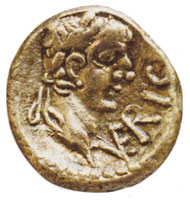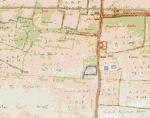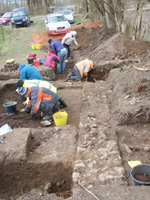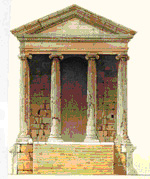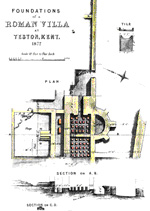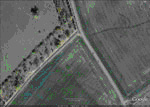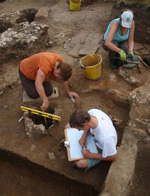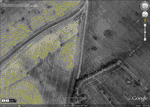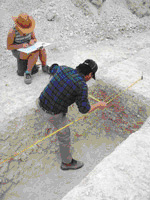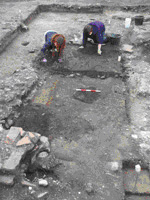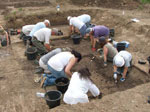 |
||||||||||||||||||||||||||||||||||||||||||||||||||||||

|
WELCOME TO THE JANUARY NEWSETTER FROM KAFS We will be sending a Newsletter email each month to keep you up to date with news and views on what is planned at the Kent Archaeological Field School and what is happening on the larger stage of archaeology both in this country and abroad. Talking of which we are extremely lucky this year to be able to dig with the University of Texas at Oplontis just next door to Pompeii. We have just three places left - so hurry with that booking!  At home we are digging the last of three Bronze Age round barrows at Hollingbourne in Kent where last year in Barrow 2 we found a crouched burial and a complete bovine burial (below). Work will continue on two Roman villa estates, one at Abbey Farm in Faversham, the other at Teston located above the River Medway close to Maidstone. Work will continue on two Roman villa estates, one at Abbey Farm in Faversham, the other at Teston located above the River Medway close to Maidstone. So, look at our web site at www.kafs.co.uk in 2014 for details of courses and ‘behind the scenes’ trips with KAFS. We hear all the time in the press about threats to our woodland and heritage and Rescue has over many years brought our attention to the ‘creeping threat’ of development on our historic well-being. Dr Chris Cumberpatch has written this letter to the Times which we need to take notice of: Sir, After your report and letters (Jan 2) it is time to stand back and look at what we may be allowing to be done to this country in the name of development and its presumed role as the solution to our economic woes. Those aiming to surround Old Oswestry hillfort with a housing development offer the feeble excuse that they are not building on the hill fort itself, while at the same time ignoring the impact on views both to and from the monument. The people of Bath are facing plans to amend green belt land around the city with housing, roads and commercial development which will severely compromise the setting of the best surviving part of the western Wansdyke, another Scheduled Ancient Monument and landscape scale earthwork. Against growing threats like these, the number of people employed to examine the impact of development on our heritage is diminishing as local governments cut their conservation, archaeological and museum staff, leaving some regions without cover at all, while those who are left have overwhelming workloads. At the same time changes to English Heritage appear likely to reduce its influence. As we are only on the edge of economic growth, what other ancient monuments will be threatened as the pace of development picks up? We need to call a halt and reinstate the ground rules for protection of our Historic Monuments (and greenbelt land) before it's too late and we need to fight for the jobs of those whose task it is to mitigate the negative effects of economic development. Our national heritage is not a luxury; in 2013 alone heritage tourism contributed some £26.4 billion to the British economy. Of what lasting value is recovery if we lose some of our most evocative and irreplaceable heritage in the process? DR CHRIS CUMBERPATCH Vice-chair, Rescue – The British Archaeological Trust MUST SEE
The Cheapside Hoard: London’s Lost Jewel’s 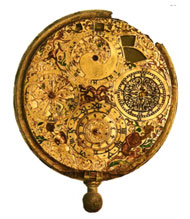 In its infancy at the time of the hoard's discovery, the Museum of London acquired most of the Cheapside treasures through an antique dealer nick- named Stoney Jack. Now all the pieces have been reassembled for the first time, coming together - under the scholarly supervision of Hazel Forsyth- not just physically but curatorially. With the help of recent technological advances the museum has tested the gold and gemstones in the hoard for purity and origin, calling on several notable gemmologists and jewellery historians for their expertise. Armed with this knowledge Forsyth has revealed the social context of these jewels in a new book, itself a treasure trove of expertise and a rich visual experience in its own right. Devotional, magical and amorous meanings are explained in minutest detail. We learn that beneath the grubby cellar floor a bloodstone cameo of Christ lay in the pitch black, cheek by jowl with a tiny profile portrait of Elizabeth I. A lyrical pink-sapphire-a diamond lover's knot was interred beside a dun-brown fossilised sharks tooth - strange bedfellows! This is a show full of fascination and amazement and not to be missed! 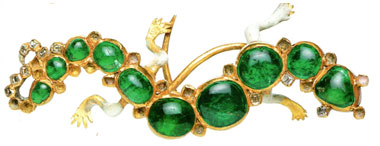 The Cheapside Hoard: London’s Lost Jewel’s runs at the Museum of London (020 7001 9844; museumoflondon.org.uk), 11th October 2013 to 27the April 2014. In March 2014 the British Museum will open the Sainsbury Exhibitions Gallery with a major exhibition on the Vikings  cultural contacts. The exhibition will capitalise on new research and thousands of recent discoveries by both archaeologists and metal-detectorists, to set the developments of the Viking Age in context. These new finds have changed our understanding of the nature of Viking identity, trade, magic and belief and the role of the warrior in Viking society. Above all, it was the maritime character of Viking society and their extraordinary shipbuilding skills that were key to their achievements. At the centre of the exhibition will be the surviving timbers of a 37-metre-long Viking warship, the longest ever found and never seen before in the UK. Due to its scale and fragility it would not have been possible to display this ship at the British Museum without the new facilities of the Sainsbury Exhibitions Gallery. The ship, known as Roskilde 6, was excavated from the banks of Roskilde fjord in Denmark during the course of work undertaken to develop the Roskilde Viking Ship Museum in 1997. Since the excavation, the timbers have been painstakingly conserved and analysed by the National Museum of Denmark. The surviving timbers – approximately 20% of the original ship - have now been re-assembled for display in a specially made stainless steel frame that reconstructs the full size and shape of the original ship. The construction of the ship has been dated to around AD 1025, the high point of the Viking Age when England, Denmark, Norway and possibly parts of Sweden were united under the rule of Cnut the Great. The size of the ship and the amount of resources required to build it suggest that it was almost certainly a royal warship, possibly connected with the wars fought by Cnut to assert his authority over this short-lived North Sea Empire. Weapons and looted treasures demonstrate the central role of warfare to the identity of the Vikings. Recently excavated skeletons from a mass grave of executed Vikings near Weymouth in Dorset, will provide a close-up encounter with ‘real’ Vikings and illustrate what happened when things went wrong for Viking warriors on British soil. The Vale of York Hoard will be shown in its entirety at the British Museum for the first time since it was discovered by metal detectorists near Harrogate in 2007 and jointly acquired by the British Museum and York Museums Trust. Consisting of 617 coins, 6 arm rings and a quantity of bullion and hack-silver the Vale of York Hoard is the largest and most important Viking hoard since the Cuerdale Hoard was found in Lancashire in 1840, part of which will also be included in the exhibition. With coins and silver from places as far removed as Ireland and Uzbekistan, the hoards reveal the true extent of the Viking global network. The silver cup in which the Vale of York Hoard was buried predates the burial by a century and was probably made for use in a Frankish church. It may well represent treasure stolen in a Viking raid. The Vale of York hoard includes objects coming from as far apart as Afghanistan in the East and Ireland in the West, as well as Russia, Scandinavia and continental Europe. Represented in the hoard are three belief systems (Islam, Christianity and the worship of Thor) and peoples who spoke at least seven languages. 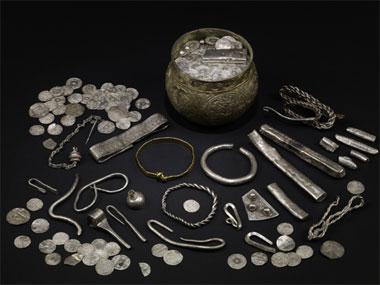 Ostentatious jewellery of gold and silver will demonstrate how status was vividly displayed by Viking men and women. These include a stunning silver hoard from Gnezdovo in Russia, never previously seen in the UK, which will highlight the combination of Scandinavian, Slavic and Middle Eastern influences which contributed to the development of the early Russian state in the Viking Age. Neil MacGregor, Director of the British Museum said “The reach and cultural connections of the Viking Age make it a remarkable story shared by many countries, not least here in the British Isles. New discoveries and research have led to a wealth of new information about the Vikings so it is a perfect moment to look again at this critical era. Temporary exhibitions of this nature are only possible thanks to external support so I am hugely grateful to BP for their longstanding and ongoing commitment to the British Museum.” “BP is extremely pleased to support ‘Vikings: life and legend’, the first exhibition of the new five year partnership between the British Museum and BP. Our support for the British Museum is part of BP’s wider contribution to British life, connecting people and communities across the UK. We are delighted to help bring this major exhibition to the British Museum.” Peter J Mather, Group Regional Vice President, Europe and Head of Country, UK, BP. Mumsnet event (Tuesday 20 May, 10.00–12.00) A full public programme accompanies the exhibition. More information is available from the press office. The exhibition catalogue is available from February 2014 by British Museum Press: Vikings: life and legend, edited by Gareth Williams, Peter Pentz and Matthias Wemhoff. A rich and vivid account of the Vikings and their cultural interactions from Asia to the Atlantic. Hardback, £45, paperback £25. A gift book, The Viking Ship by Gareth Williams, is also available from February 2014. Paperback, £9.99 Also available from British Museum Press, published March 2013, Viking Poetry of Love and War, by Judith Jesch. An accessible introduction to the broad poetry ranges of the Vikings, from the highly formal to the light-hearted. Paperback, £9.99. Vikings in Britain and Ireland by Jayne Carroll, Stephen Harrison and Gareth Williams, a fascinating illustrated introduction to the cultural influence of the Vikings in Britain and Ireland. Paperback, £10.99. A children’s book, The Adventures of Harald: Last king of the Vikings, by Thomas Williams, is an illustrated adventure telling the story of King Harald Sigurdsson, the last King of the Vikings. Paperback £7.99. Follow updates on the exhibition via Twitter on #VikingsExhibition and the Museum’s Twitter account @britishmuseum Tickets can be booked online at britishmuseum.org or 020 7323 8181.Opening hours 10.00–17.30 Saturday to Thursday and 10.00–20.30 Fridays. Open on Good Friday 18 April, 10.00–17.30. 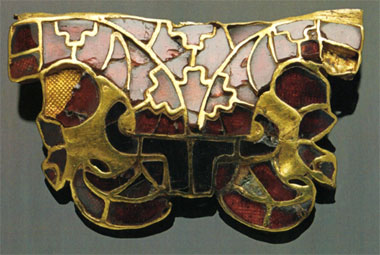 STUDY DAYS Staffordshire Hoard KAFS Visit on Friday 9th May at 10.00am. Birmingham Museum and Art Gallery with, Dr David Symons, Curator of Antiquities and Numismatics. £75 for members and only ten places available!
10.00 Arrive at the Birmingham Museum for tea, coffee and biscuits The first pieces of the Staffordshire hoard were found in early July 2009 by Mr Terry Herbert while he was metal detecting in a field in southern Staffordshire. Mr Herbert reported the find to the Portable Antiquity Scheme's Finds Liaison Officer for Staffordshire and the West Midlands, based here at Birmingham Museums & Art Gallery. Because the find was so important, English Heritage and Staffordshire County Council funded an archaeological excavation which was carried out between 24 July and 21 August by Birmingham Archaeology. Following the excavation Mr Herbert found a few more pieces, but a final search of the site 14-15 September by a specialist police remote sensing team found nothing else, so it is likely that the entire hoard has been recovered. What the hoard contains 
What has happened since? The Treasure Valuation Committee recommended the value of £3.285 million to the Secretary of State and this has now been agreed with Birmingham and Stoke City Councils as well as the finder and landowner of the Hoard. Hoard Saved for the Nation On 23 March 2010 The Art Fund announced that the Staffordshire Hoard has been saved for the nation. The news came after the National Heritage Memorial Fund (NHMF), the government's fund of last resort for heritage items at risk, pledged £1,285,000, bringing the campaign to the £3.3m target, just over three weeks ahead of schedule. Thanks to the support of the public, trusts and foundations, and the generous £1,285,000 NHMF grant, the find has now been safely secured for Birmingham Museums & Art Gallery and the Stoke Museums.  To join the ‘behind the scenes’ visit with KAFS on Friday 9th May 2014 email your booking to [email protected] Places available for ten members only at £75 per person. Summer sunrise from inside the stones of Stonehenge with Dr Paul Wilkinsonon Friday 23rd May. £75 for members with only ten places available
05.15 Meet at the new Visitor Centre  For a take on the present state of Stonehenge and its new Visitor Centre Richard Morrison writing in the Times said: ‘Tomorrow, of course, is the biggest day of the year, as well as the shortest. It's the Winter Solstice, the moment when Stonehenge is perfectly aligned with the rising and setting sun. The hippies and "druids" may mostly prefer to gather there at midsummer, but the evidence suggests that for our Neolithic ancestors, who spent millennia worshipping there, the winter ritual was more important. It is for me as well! During the summer this part of Salisbury Plain fits Ernest Thesiger's famous remark about the First World War: "My dear, the noise, the people!" You can't move for coach parties — literally, if you are jammed on the permanently clogged A303. Whereas in midwinter, half shrouded in mist or lashed by rain, Stonehenge looks just as it should: gaunt, desolate, elegiac, enigmatic. Almost, in fact, as Constable painted it in 1836: "remote on a bare and boundless heath". The heath isn't quite "bare and boundless" these days. But this week English Heritage (EH) and the National Trust (which respectively manage Stonehenge and the land around it) took a giant step towards returning some prehistoric calm to this landscape. On Wednesday [17th December 2013] EH opened its new visitor centre. That sounds prosaic in the context of a 4,300- year-old monument, but this fine Denton Corker Marshall creation in wood and glass represents a huge advance in how Stonehenge is understood by the million people who visit it each year. For a start, the visitor centre, and all its attendant car parks, is 1.5 miles from the monument itself. The old visitor centre, now being demolished, was a pile of Sixties crud and commercialism right by the stones. By next June all traces of its sorry existence will be grassed over, as has already happened to the old A344 which ran right past the stones. Instead, visitors will be driven to the stones in shuttles. Or, better, they will walk across the Plain, perhaps taking in the Avenue and Cursus: the ancient processional path and earthworks round Stonehenge. As important as the landscape's restoration, however, is the exhibition inside the new visitor centre. As Simon Thurley, EH's boss, says: "Over the past ten years our understanding of this place in Neolithic times has been transformed. We had thought this was an empty landscape, where people came for ceremonies. Now we have discovered the people, what they ate and wore, and even how they did their hair." All of that is incorporated in an exhibition that will blow the mind of anyone interested in our isles' prehistory. Here are the stone, flint and animal-bone tools that shaped Stonehenge in that pre- Bronze Age, the sacred jewellery, cups and axes buried in the mounds, and, most spectacular and controversial of all, a skeleton of an early Neolithic man, found just a mile away.  What's more, his face has been reconstructed with the help of modern marvels such as isotope analysis. (Pity he ends up looking like Mel Gibson in Braveheart — but don't they all?) In a few months, too, a Neolithic village will also be reconstructed, based on houses just excavated three miles from Stonehenge. The exhibition also contains a 360-degree film showing what it must have been like to stand inside the circle when it was complete (if it was ever complete), as well as documents showing how Stonehenge has been explained over the past 900 years. We may laugh at the medieval belief that the stones were magicked from Ireland by Merlin, or at Inigo Jones's drawing of the "Roman temple" he thought the stones supported — but we are far from knowing all the answers. As Thurley says, however, we do know so much more than we did a decade ago. So although the years of dithering in sorting out this site have been frustrating, the delay has paradoxically worked to the advantage of scholars, tourists and taxpayers alike. Had the grandiose Stonehenge project mooted back in 2003 gone ahead, the visitor centre would have cost £75 million, with another £200 million required to put the A303 in a tunnel. This present scheme has cost just £27 million — not a penny provided by Government — and visitors will benefit from the astounding discoveries of the past few years. In short, a triumphant compromise snatched from the jaws of muddle and procrastination. Very British. Richard Morrison To join the ‘behind the scenes’ visit with KAFS on Friday 23rd May 2014 email your booking to [email protected]. Places available for ten members only at £75 per person. A day in Bath followed by a Twilight Tour & Dinner in the Roman Baths. KAFS Visit on Saturday 13th December at 9.30am with Stephen Clews Curator of the Roman Baths. 9.30 Introductory talk by Stephen Clews  A day in the beautiful Cotswolds and the graceful city of Bath will reveal the Roman heritage of the area. Our tour leader will be Stephen Clews, Curator of The Roman Baths for the last 16 years, and prior to that Assistant Curator at the Corinium Museum in Cirencester. The study day begins with an introductory talk by Stephen Clews followed by a gulp of spring water in the Great Pump Room at Bath. Then we visit the Roman Baths and Temple complex built around the hot springs of Bath, which became a place of pilgrimage in the Roman period. This tour will include special access to underground passages and the spa water borehole. The spa theme will continue as we trace the story of seven thousand years of human activity around the hot springs, which has created this World Heritage city. The afternoon will conclude with a walk around the Georgian upper town. In the early evening we meet up at the Roman Baths for a torchlit guided tour of the Roman Bath Museum followed by Dinner at the Roman Baths Kitchen opposite the main entrance to the Roman Baths. To join the ‘behind the scenes’ visit with KAFS on Saturday 13th December 2014 email your booking to [email protected]. Places available for ten members only at £75 per person. FIELD TRIPS Join KAFS on a field trip on 26th-28th September 2014 to Zeugma. It is a not a trip for the light-hearted but there are direct flights by Turkish Airlines direct to Gaziantep from Gatwick at about £250 return. Local accommodation and a local mini-bus plus local guide will be available and Dr Paul Wilkinson will be your guide. We have nine places left, mini-bus and museum costs to be shared among members. The ancient city of Zeugma was originally founded as a Greek settlement by Seleucus I Nicator, one of the generals of Alexander, in 300 BC. King Seleucus almost certainly named the city Seleucia after himself; whether this city is, or can be, the city known as Seleucia on the Euphrates or Seleucia at the Zeugma is disputed. The population in the city at its peak was approximately 80,000.  In 64 BC Zeugma was conquered and ruled by the Roman Empire and with this shift the name of the city was changed into Zeugma, meaning "bridge-passage" or "bridge of boats". During Roman rule, the city became one of the attractions in the region, due to its commercial potential originating from its geo-strategic location because the city was on the SilkRoad connecting Antioch to China with a quay or pontoon bridge across the river Euphrates which was the border with the Persian Empire until the late 2nd century. Museums we will visit include:
• Archaeological Museum This local archaeological museum hosts some stunning mosaics excavated from the nearby Roman site of Zeugma. The museum, which also has a small cafe inside, is wheelchair accessible. 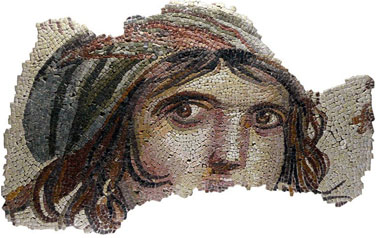 For more information on Zeugma see: http://www.zeugmaweb.com/zeugma/english/engindex.htm BREAKING NEWS King of Kings Yesterday, it was dubbed "the seat of power", but for over a decade the single fragment of thousand-year-old pelvis lay unstudied and unloved in Winchester museum's archives. No longer. It seems that this overlooked bone could be the pelvis that rode against the Danes—the first glimpse in a thousand years of the man who united a nation, championed the English language and remains our only monarch to gain the title "Great": King Alfred. An investigation into remains found beneath the high altar of an old abbey in Winchester has found a bone belonging to a middle-aged man from the 9th century. The only documented burials in the site that fit that description were of Alfred the Great, and Edward, his son, also a king, who extended the writ of Wessex as far north as the Humber. Now the hope is to excavate further and uncover the rest of him. Archaeologists analysed the bones as an afterthought, after investigators inspired by last year's discovery of Richard III under a Leicester car park exhumed a skeleton that local legend maintained was that of Alfred. Those remains turned out to be from centuries later, but having hired the services of a radiocarbon-dater they also looked at other bones dug up nearby in the 1990s. "We were so disappointed when we heard about the skeletons," said Rose Burns, a resident who had campaigned for the examination, conducted by the University of Winchester. She did not hold out much hope for the other tests.
There they remained in a tomb by the altar until the Reformation, when the Abbey was levelled.Further complications came in the 18th century, after a prison was built on the site and the bones were scattered. However, in 1866 a Victorian archaeologist claimed to have found the grave of the Wessex family, complete with royal memorabilia as proof. He sold the bones to a local vicar for 10 shillings, but not before the "memorabilia" was shown to be an incompetent forgery. Those were the bones that were initially tested and shown to have been far too recent. However, the fact that the abbey was built in the 12th century meant that any other bones, such as the pelvis, found on the site dating from earlier were highly likely to be those of the Wessex family. "The simplest explanation, given there was no Anglo-Saxon cemetery at Hyde Abbey, is that this bone comes from one of the members of the West Saxon royal family," said Dr Katie Tucker, who performed the tests. The hope is that further investigations could not just uncover more of the skeleton but also establish firmer evidence that it is Alfred or Edward. Mr Fennel says the bone, which he calls the "Seat of power of the Royal House of Wessex", could be the beginning of a new chapter in the eventful history of Alfred's remains. A team led by Oxford University is keen to continue the investigation and Winchester University has guaranteed funding, but the site is now on community land. "We need to get the gardeners to agree to let us dig it up," said Mr Fennell. The ‘Times’ comments in its leader that: First, a year ago, came the news that the body of Richard III had been found, having lain in Leicester for over five centuries beneath what had become a car park. Yesterday, yielded from the rather more dignified hiding place of a Winchester abbey, emerged bones which both documentary evidence and scientific analysis suggest are likely to belong to a much more celebrated English monarch — Alfred the Great. In the niche business of regal remains recovery, these past 12 months have proved exceptionally fruitful. King Richard died in 1485. If that date appears almost unimaginably distant, then consider 899, when King Alfred breathed his last, fully 1,115 years ago. As the man reputed to have invented the first rudimentary clock — using a candle — Alfred would savour these statistics describing the immense span between his interment and his (probable) discovery. Reportedly wedded to technological progress, he would also surely salute the ingenuity his descendants can now deploy to make such judgements. Human intelligence has once again been shown to respect no boundaries. Who knows? One day even the fantasies of The Da Vinci Code, linking Jesus to human descendants in Scotland, may sensationally be proved true. It is no accident that Alfred, alone among English monarchs, has earned the suffix "great". He was the first monarch with a claim to be a truly national leader. He resisted invasion. He succeeded in unifying territory that became, and is, a recognisable sovereign state. Should the remains in Winchester be confirmed as his — DNA analysis could identify a modern-day relative, Alfred the Mediocre or some such — the full pomp and ceremony of a royal funeral is warranted. In honouring a man of this calibre, being a millennium or so late counts as a mere detail. Silchester dig reveals vast pre-Roman buildings Norman Hammond writes: One of the largest prehistoric buildings known from ancient Britain has been uncovered below the Roman city of Silchester. Dating to around the time of Christ, and a few decades before the Roman conquest of AD43, the timber structure in Hampshire was more than twice as long as a cricket pitch, and "without parallel in Iron Age Britain", according to Professor Michael Fulford, of Reading University. The structure has been gradually revealed by Professor Fulford's excavations of an entire insula or city block near the centre of Calleva Atrebatum, the Roman name of this city of the Atrebates tribe near modern Basingstoke. Calleva is notable as one of the few Roman cities still exposed, rather than built over in medieval and later times: as a result the Insula IX Town Life Project, now approaching its final season in 2014, has been able to explore more than 2,000 square metres of the Roman and pre-Roman community. In 2012, some 24 metres of the long building were found: this year its footprint has been extended to 44 metres (143ft), and the north eastern end has still not been located. "The sheer size of the building is astonishing". Professor Fulford said. "Whether we shall establish its complete plan within the limits of our excavation trench remains to be seen." Equally striking is the discovery that this was but one of a succession of important structures on this spot, built, demolished and rebuilt over no more than a couple of generations. The first was a rectangular hall built of timber posts, 15 metres long and 4.5 metres wide, aligned from northwest to southeast and dated by associated Finds to after 20BC. This was soon replaced by the extended hall of more than 44 metres, built, surprisingly, on the opposite alignment from northeast to southwest, and this was in turn quite soon replaced by a smaller but still impressive post-built hall more than 23 metres by 11 metres. (75ft by 36ft) in size on the same orientation. Even more surprising to Professor Fulford was that in between these two phases of major construction a modest round house only five metres in diameter was constructed. It was, however, associated with luxury goods including imported continental tablewares, suggesting an elite building with apparently chiefly residents are known from other sites of this period, including one near Thetford in Norfolk which may have been the home of Boudicca's father, Prasutagus, ruler of the Iceni. The entire sequence seems to fall within some 40 years, the last two decades before and the first two after the birth of Christ. "These belong within the timespan of one or two generations," Professor Fulford said. Even the last building did not last long: it was covered by a cultivated soil for some 20 years before the Roman conquest and the foundation of Calleva Atrebatum on the site of the Iron Age community. "Nowhere else on the site is there a comparable succession of timber buildings, high-status buildings being replaced after as little as ten years," Professor Fulford observed. "One implication is of intense rivalry and political turbulence among leading members of the Atrebates, the seizure of property, and the conspicuous taking down and replacement of significant buildings." Atrebatic coinage, left, shows a succession of four rulers, with images and Latin inscriptions "claiming close affiliation with the world of Rome".
Although the remains of the city lie today in green fields, its former strategic importance is unmistakeable. 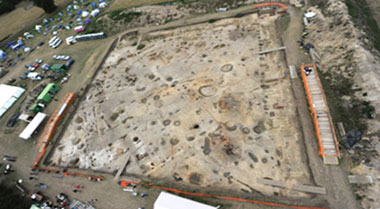 To find out more and to participate in excavations at Silchester see - http://www.reading.ac.uk/silchester/Excavations/sil-excavations.aspx Secret caves at Lascaux by Louise Callaghan The Lascaux caves have about 2,000 frescoes — some as much as 17,000 years old — depicting hundreds of images of animals. They were stumbled upon by a group of teenagers in the summer of 1940. The caves were initially swamped with visitors and have been closed to the public since 1963 to protect their priceless art from humidity, mould and human breath. 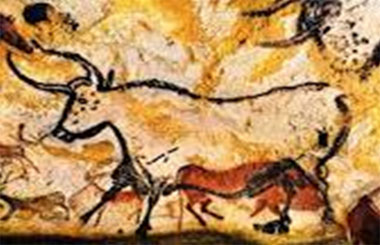 Now, after decades of rumours, the authorities in Montignac, the nearest town, are investigating the possibility that a similar set of caves may exist 2 miles away from the first. Laurent Mathieu, the mayor of Montignac, launched the investigation after an extraordinary tip-off from a resident. In August a 70-year-old woman had told him that her late husband and brother-in-law had stumbled across another set of painted caves back in 1962. Instead of taking credit for the find , they sealed the caves to prevent their locale becoming a tourist magnet. The family were sworn to secrecy until, at the insistence of her children , the woman went to the mayor. Although he initially did not take her story seriously, he has now launched an investigation into the caves' existence. "We will search the terrain closely to see if we'll find the caves," said Laurent. Early inquiries have proved promising enough to permit a detailed search by local experts and regional authorities. An area of 25 acres has been placed under discreet police protection to ward off any invasion by treasure hunters. "If there is anything, it's a huge discovery," said Laurent. "But we can't make any big revelations at the moment." For more details on the Lascaux caves see - http://www.lascaux.culture.fr/#/fr/00.xml READING AT THE MOMENT Under Another Sky. The news of another book about Roman Britain provoked an initial groan; and, to make it worse, one by a journalist… But it turns out to be one of the best and, once started, it’s hard to put down. Its structure and narrative are finely crafted; anticipation of encountering its treatment of the familiar, and often the unfamiliar, draws the reader on.  Every reader will find his or her own pleasures and lessons here. It may be the main thesis, that the Romans have shaped our physical and emotional selves more than is sometimes acknowledged, at least by those who regard the Roman occupation as merely a temporary blip on the progression of our island’s history. For me, there were two things. The first is the way that Higgins caresses the places she visits with a love and deep knowledge of literature; for example, she fascinates as she entwines the story of female warriors from Boudica to Victoria via Tacitus, Horace, Holinshed, Shakespeare and many others. The second is her sense of place and her ability to recreate it; perhaps Londoners are privileged, as she walks up Edgware Road or through Barnsbury Square, but she is a keen observer of natural landscapes, whether wandering through the Mendips or struggling (as we all do) to find Silchester. We feel we too, her companions, have sailed with her in the camper van, and are there, on the site, listening to her. And, what a pleasure to have all this as a book, with subtleties that can be revisited; and not a TV programme. Andrew Burnett SHORT STORY “If history were taught in the form of stories, it would never be forgotten” Rudyard Kipling Faction articles of life in Roman Kent by Paul Wilkinson have been published monthly in the county newspaper of Kent and are a hit with readers. For the amusement of academics read on! 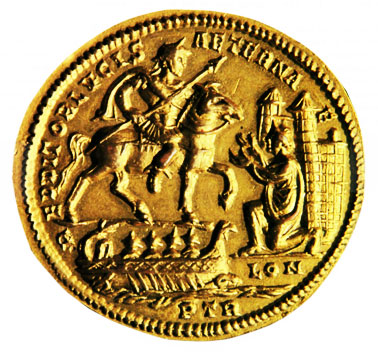 In 2001 fieldwork by the Kent Archaeological Field School found the original lost route of the Roman Watling Street just to the west of Faversham in Syndale Park. Some years later KAFS returned and cut a section through this Roman road. It turned out to be about 12 metres wide (40ft), and was in extremely good condition and consisted of coarse sand mixed with fine gravel. Large flint stones had been used as a retaining kerb which showed up well in the geophysical survey. On the north edge of the road we found the frontage of a substantial stone-built Roman building. In the doorway leading directly on to the road discarded Roman pottery lay strewn about and on the edge of the road itself the remains of a hob-nailed boot and 14 Roman coins including two of silver....
He offered me his hand in friendship and told me his name was Marcus Favonius Honoratus. I looked him over and saw the indicators of rank, his vine cane (vitis), the sword (gladius) carried on the left, and his chain mail vest told me he was a senior centurion of a legion. “Look out, here they come”, and over the rise of hill the far side of Ospringe I saw a Roman Legion advancing along Watling Street. Roman cavalry rode in front and at the sides of the advance party of a contingent of legionaries in close order followed by ten men from each legion to mark the route and clear away obstructions. I then saw the commander with his own bodyguard. “Who is that” I asked. “That is Constantius Chlorus, one of the greatest generals we have, and sent to sort out this mess out by Allectus going AWOL and trying to break away from the Roman Empire. Watch out, they are getting closer”. We moved to the side of the road as Constantius passed, and as he did he looked me up and down quizzically and made a sign to the centurion to keep an eye on me. Then came the legions led by its eagle and other standards, the men marching six abreast. As they tramped past the ground shook, it took two hours for the army to pass, tens of thousands of men, cavalry and pack horses. “Where are they off to I asked?” “To save Londinium from the Franks and restore Imperial power to the province” Marcus said. “I must go now, so look after yourself”. I looked around and saw people returning to their damaged or destroyed homes and shops in the small Roman town here at Syndale Park. I looked down and saw that Marcus had forgotten to pick up the coins, I bent down and started to collect them, and as I looked up the scene was as I had left it with archaeologists digging and recording one of the great roads of the Roman Empire. The Roman road from Richborough and Dover to Canterbury and then on to London (all three were Roman towns) was one of the great achievements of the Romans in Britain. Built in about AD50, some six years after the initial conquest by Claudius in AD43 it ran beyond London for almost 300 miles, and in Kent for the most part is routed as the A2. COURSES
KAFS BOOKING FORM You can download the KAFS booking form for all of our forthcoming courses directly from our website, or by clicking here KAFS MEMBERSHIP FORM You can download the KAFS membership form directly from our website, or by clicking here |
|||||||||||||||||||||||||||||||||||||||||||||||||||||
 If you would like to be removed from the KAFS mailing list please do so by |
||||||||||||||||||||||||||||||||||||||||||||||||||||||

